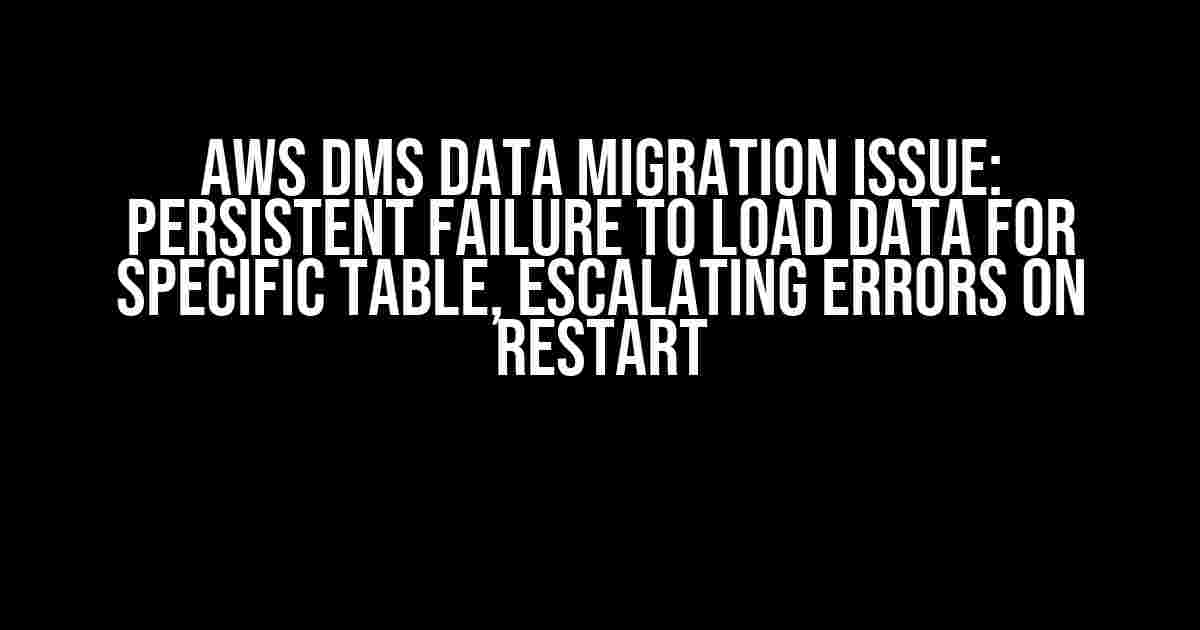Are you tired of dealing with persistent failures to load data for a specific table in AWS Database Migration Service (DMS)? Are escalating errors on restart driving you crazy? You’re not alone! In this article, we’ll dive deep into the possible causes and provide step-by-step solutions to overcome this frustrating issue. Buckle up and let’s get started!
Understanding the Issue
The AWS DMS data migration issue occurs when the service fails to load data for a specific table, despite successful connections to the source and target databases. This issue can manifest in various ways, including:
- Persistent errors during data loading, with no clear error messages
- Data truncation or corruption during the migration process
- Escalating errors on restart, making it difficult to troubleshoot
- Long-running migrations that never complete
Possible Causes of the Issue
To fix the issue, it’s essential to understand the underlying causes. Here are some possible reasons behind the persistent failure to load data for a specific table:
1. Incorrect Source Endpoint Configuration
Double-check your source endpoint configuration to ensure it’s correct. Verify that:
- The endpoint type matches the source database type (e.g., Oracle, MySQL, PostgreSQL)
- The server name, port, and database name are correct
- The username and password are valid and have the necessary permissions
2. Insufficient Permissions
Ensure that the AWS DMS user has the necessary permissions to access the source and target databases. You can check the permissions by:
- Verifying the IAM role attached to the AWS DMS instance
- Checking the database user permissions for the source and target databases
3. Large Table Size or High Data Volume
If the table is extremely large or has a high data volume, it can cause performance issues during the migration process. You can:
- Split the table into smaller chunks for faster migration
- Optimize the table structure and indexing for better performance
4. Network Connectivity Issues
Network connectivity problems can cause the AWS DMS to fail during data loading. Ensure that:
- The network connection between the source and target databases is stable
- Firewall rules are configured to allow traffic between the databases and AWS DMS
5. Data Type Incompatibilities
Data type incompatibilities can occur when the source and target databases have different data types for the same column. You can:
- Use AWS DMS’s built-in data type conversion features
- Manually convert the data types using custom scripts or ETL tools
Solution: Troubleshooting and Fixing the Issue
Now that we’ve covered the possible causes, let’s dive into the step-by-step solution to fix the AWS DMS data migration issue:
Step 1: Review the AWS DMS Error Logs
Start by reviewing the AWS DMS error logs to identify the specific error messages related to the failing table:
<Error>
<Code>Error Code: 123456789</Code>
<Message>Error message: Unable to load data for table 'table_name'</Message>
</Error>
Step 2: Verify Source Endpoint Configuration
Double-check the source endpoint configuration using the AWS Management Console or AWS CLI:
aws dms describe-endpoints --endpoint-arn arn:aws:dms:us-east-1:123456789:endpoint:my-source-endpoint
Step 3: Check Permissions and Access
Verify the permissions and access for the AWS DMS user using the IAM console or AWS CLI:
aws iam list-attached-role-policies --role-name my-dms-role
Step 4: Optimize Table Structure and Indexing
Optimize the table structure and indexing for better performance using SQL commands or database management tools:
ALTER TABLE my_table
ADD INDEX idx_my_column (my_column);
Step 5: Test Network Connectivity
Test the network connectivity between the source and target databases using tools like Telnet or Ping:
telnet my-source-db 5432
Step 6: Resolve Data Type Incompatibilities
Resolve data type incompatibilities using AWS DMS’s built-in data type conversion features or custom scripts:
CREATE TABLE my_target_table (
my_column VARCHAR(255) NOT NULL
);
Step 7: Retry the Migration
Rerun the migration task with the corrected settings and monitor the progress:
aws dms start-replication-task --replication-task-arn arn:aws:dms:us-east-1:123456789:task:my-replication-task
Conclusion
In this article, we’ve covered the possible causes and solutions for the AWS DMS data migration issue related to persistent failures to load data for a specific table. By following these steps, you’ll be able to identify and fix the issue, ensuring a successful data migration to your target database. Remember to monitor your migration tasks closely, and don’t hesitate to reach out to AWS support if you need further assistance.
| Causes | Solutions |
|---|---|
| Incorrect Source Endpoint Configuration | Verify source endpoint configuration, IAM role, and database user permissions |
| Insufficient Permissions | Check IAM role and database user permissions, attach necessary permissions |
| Large Table Size or High Data Volume | Split table into smaller chunks, optimize table structure and indexing |
| Network Connectivity Issues | Verify network connectivity, check firewall rules, and test connectivity |
| Data Type Incompatibilities | Use AWS DMS data type conversion features or custom scripts to resolve incompatibilities |
By following this comprehensive guide, you’ll be able to overcome the AWS DMS data migration issue and ensure a successful data migration to your target database.
Remember to bookmark this article for future reference and share it with your colleagues who might be facing similar issues. Happy migrating!
Frequently Asked Question
Are you stuck with an AWS DMS data migration issue where a specific table refuses to load, and errors escalate on restart? Worry not, we’ve got you covered!
What are the common causes of persistent failure to load data for a specific table in AWS DMS?
Some common culprits behind this issue include incorrect table mapping, incompatible data types, insufficient storage capacity, network connectivity problems, and SQL syntax errors. Ensure you’ve double-checked these potential causes before proceeding.
How can I troubleshoot the escalating errors on restart during AWS DMS data migration?
To troubleshoot, review the AWS DMS logs to identify the specific error messages and error codes. Then, verify the table schema, data type compatibility, and SQL syntax. If necessary, re-create the table and re-run the migration task. You can also consider reaching out to AWS Support for further assistance.
What are some best practices to avoid data migration issues in AWS DMS?
To minimize data migration issues, ensure you’ve thoroughly tested your migration task, validated your table schema and data types, and allocated sufficient storage capacity. Additionally, consider using AWS DMS best practices, such as implementing data validation rules and employing change data capture (CDC) for real-time data replication.
Can I use AWS DMS to migrate data from an on-premises database to Amazon RDS?
Yes, you can use AWS DMS to migrate data from an on-premises database to Amazon RDS. AWS DMS supports various source and target databases, including Oracle, MySQL, PostgreSQL, and Microsoft SQL Server. This allows you to migrate your on-premises database to Amazon RDS, taking advantage of the scalability and reliability of the cloud.
What are some additional resources available to help me with AWS DMS data migration issues?
For additional guidance, visit the AWS DMS documentation, which provides detailed tutorials, troubleshooting guides, and best practices. You can also explore the AWS re:Post community, where you can ask questions and get answers from experienced users and AWS experts. Furthermore, consider consulting with an AWS-certified professional or reaching out to AWS Support for personalized assistance.



